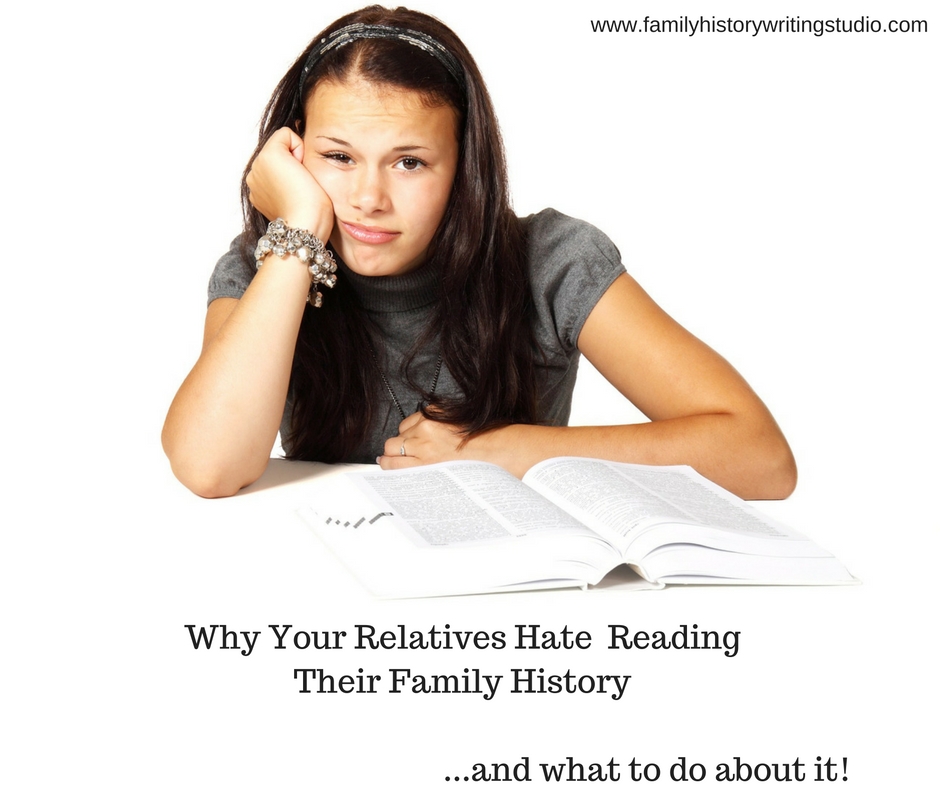It’s not uncommon to start writing your family history stories using summary, telling our family history stories by summarizing our facts into paragraphs. But after a while we soon realize this does not make for an engaging story and we need to learn how to show rather then always tell. Today, we gathered together some tips to help you learn how to transition your writing from telling to showing.
How to Transition from Telling to Showing
3 thought on “How to Transition from Telling to Showing”
Comments are closed.
Related Post
How to Share Family Stories during the HolidaysHow to Share Family Stories during the Holidays
In just 15 minutes a day over 5 days you could write a small family story scene that could be shared in some interesting ways over the holiday season. Watch to learn how than click here to download your free resource to help you.

Why Your Relatives Hate Reading Their Family HistoryWhy Your Relatives Hate Reading Their Family History
Does your family object to reading their family history? Do you get the big eye roll when you offer them a story you wrote or an opportunity to preview a book your writing? Our families are completely uninterested in reading their family history. Many of us struggle with this. I know I did. Then I learned about writing scenes and about how the right balance of scene and summary can bring an ancestor to life on the page. When you learn the skill of writing scenes your stories become entertaining and compelling all the things necessary to engage your family and hold their interest.
What is a Scene?
Scenes are action, they usually include dialogue, description, conflict, thoughts, and feelings. When we read them, they are meant to play out like a movie in our brain. When we write nonfiction stories, we intermingle scenes with summary.
What is Summary?
Summary is just as it states it is an account of an event or time. The reader is given information in a brief format to move the story along. Sometimes summary will cover a span of years to speed up a story or fill in background information to add depth to a story. As family historians, we fall into the trap of writing everything, our entire story, in a summary format. This why our stories are boring.
We need to learn the skill of writing scenes and then to find the right balance of scene and summary to lay out a story.
How do we take a document like a passenger list or a marriage certificate or the birth of a child and bring it to like on the page? How do we but our reader there and allow them to experience the event as if it is playing out before their eyes – using scene.
When we combine scene with narrative summaries, we are writing creative nonfiction. That term creative nonfiction tends to scare many. They feel they are moving away from the facts and making things up. But that is entirely wrong. Creative nonfiction is taking the facts and laying them out on the page using scene and summary – using the tools of fiction writers while writing true stories.
Regardless of whether you are writing a family history narrative in third person or a memoir in first person scenes should be a part of your writing formula. Irrespective of whether you are writing a family history in a short story format or an epic novel you need to be using scene and summary to capture and hold the attention of your readers.
What is a family history scene?
How does a scene that you read in a novel differ from a family history scene you would read in a family history story? A family history scene takes an event in your ancestor’s life, getting on a ship to America, voting for the first time, giving birth, getting married, proposing to their spouse or signing the documents to own their first acre of land and then using action, dialogue, description, conflict, and emotion bring it to life on the page.
As family historians, we collect information about this event, information that we garnered from our research, our documents, information from interviewing those who were present at the event or have heard stories of the event. With those facts in hand, we take it one step further, we put the event within a social context of the place and time –we do some social history research. We set the stage by painting a setting of where the event was held. We describe it in detail giving it life.
Next, we put the characters into that setting, our ancestors. How did they look and act? Human nature, diaries, interviews and the actions of our ancestors will give us plenty of insight into the behaviours and motivations.
As I have suggested, a family history scene is born out of the records we have acquired in our research. Research we have identified and analysed and then interpreted into a scene in our story. We make it clear to the reader the facts versus our speculation.
Sounds easy right? Well for some it does come easy and for others, it takes some practice, actually, for most, it takes some time to learn the skills and then to practice those skills. But once you have the knowledge of scene writing you’ll never turn back to strictly writing a dry narrative summary.
Do you want to learn the skill of scene writing?
It’s not enough for me just to tell you what constitutes a scene and how it will transform your boring stories into  entertaining stories. The real learning comes in building scenes. I wanted to help writers acquire those practical skills of scene writing so I created an online workshop, Writing a Family History Scene. In this 6-week course, we work through each element building a robust scene one you will be excited to say you wrote.
entertaining stories. The real learning comes in building scenes. I wanted to help writers acquire those practical skills of scene writing so I created an online workshop, Writing a Family History Scene. In this 6-week course, we work through each element building a robust scene one you will be excited to say you wrote.
Here’s what some past students have said about this course.
Kim Said:
I thoroughly enjoyed completing this course in “Writing a Family History Scene” and would recommend it to all aspiring family history writers. It is inspiring when you can see yourself and your fellow students improve so much by the end of the course. Lynn’s teachings have given us the tools to carefully craft our stories for the enjoyment by our families. I have learned so much.
Denise Said:
This course opened my eyes to scene structure. My writing improved immensely once I had the right tools and guidance to build a scene properly. This is my second Family History Writing Studio course, and it will not be my last. Between Lynn’s excellent guidance and the input from the other students, it was an interactive learning experience I highly recommend to anyone who is thinking of writing a family history narrative. In order to do any job properly, you need the right tools and, in my opinion, this is the place to build your toolbox.
If you’re ready to write a non-boring family history story, then join us for Writing a Family History Scene.

The more that I experience your workshops and writing tips, the more that I become attuned to my ancestors’ stories. Already my writing style and thought about my ancestors have changed. While I am attending to a long, novella right now, sometimes my mind slips back to the beginning of February when introduced to your writing concepts, I knew something was wrong with the “stories” of my ancestors that I had written. As soon as the novella is completed, my plan is to use those boring summaries of my ancestors and begin to enhance them with real scenes that already I am playing with in my mind. Thank you for really making me think about writing styles that I have gravitated toward in my reading over the years and what makes me come back to that same author time after time.
This is all very well and great advice if one was actually there to experience grandma’s apple pie but how do you apply this to the telling of long past relatives who lived and died a hundred years or more before you lived? This is the problem I face when all you have is a name, DOB or death date, marriage records, parents, siblings or children’s names and perhaps a census record with their occupation (although not always). I have looked up the social history of the place and time but can only suppose or surmise what sort of life he may have lived! Surely many family history writers must face this same problem but how?
I tuned into your expert video and in the past three years had written 150 thousand words of my life growing up in the early 1950’s – 1967 , when I eventually moved away to get married and start another way of life. I had also tried a different way of writing, that is the funny, sad, odd things that happened in the 17 house moves that we experienced. In that account or several accounts, I had separate stories with dialogue, scenes set up but not so descriptive as you describe in detail. I have written a draft (first) of those stories to show my adult children and the Grandkids how hard it was growing up without the modern conveniences. Sometimes we just had bare essentials like electricity for lights, but no heat etc. We lived through harsh winters and floods and a house fire at 3am one January with a minus 35 F degrees, running out into the snow barefoot to reach to reach the awaiting car.
Again, I recalled the scenes as they happened and was able to write down the actual scenes with dialogue, but not too descriptive. I intend to do a second draft to include detailed descriptive scenes, but I worry that it may detract from the story,becomming too long and drawn out for each event as it happened? This stops me in my tracks from writing and I have taken a hiatus in the meantime to take a break from what became was a grueling 10 hours a day of writing. (Once I start, I am driven to finishing it as I recall vividly in my mind and afraid that I may forget something important. I do this every November for NANAWRIMO competition. My Future Novel is expanding to include mush more as Chapters of different themes, this is all for my family to leave a legacy of from where they descended from and all the actual events that shaped us and them in the present…It is important to get this written and completed before I pass on (prob not for years but, just in case , I want to have a completed draft for them.